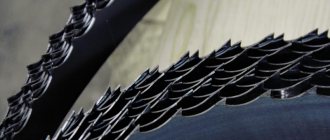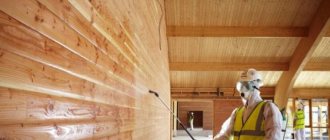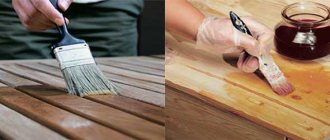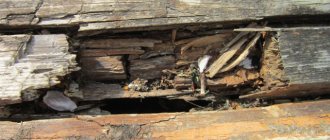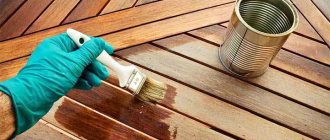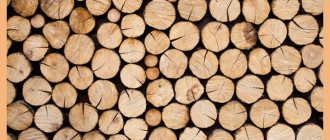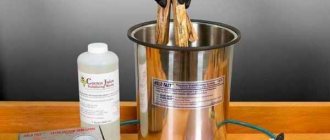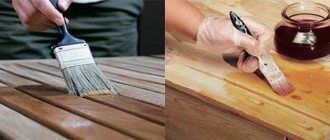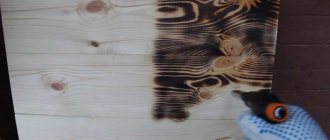When treating wood with paint or varnish, you cannot be sure that the material is completely protected from pests and rot. Surface treatment of products with waterproof agents protects against external moisture entering the wood texture. But, since the tree contains tree sap, the product is subject to rotting processes over time. Treating wood with copper sulfate prevents any decay processes without changing the shade of the wood. An important advantage of the composition is its harmlessness to humans and animals.
Why coat wood with copper sulfate?
Treating timber with copper sulfate is the best way to improve performance, from freshly cut wood to finished buildings. The texture of wood fiber is very similar to a kitchen sponge. Wood absorbs moisture not only in direct contact with water, but also from the air at high humidity levels.
If the lumber is dried incorrectly or insufficiently, the remaining tree sap leads to rotting of the entire structure. Treating wood against rotting with vitriol is an effective antiseptic. Copper sulfate is a blue powder that does not have a distinct odor. The sulfuric acid salt is moderately toxic to animals and humans, but bacteria and many insects living in the body of wood die from their high toxicity.
Copper sulfate is characterized by the following parameters:
- has an astringent effect;
- has antiseptic properties;
- disinfects the treated area.
When processing raw materials or a finished product with a solution, the fungi, bacteria and insects already present in it are killed, and further infection by woodworms, mold microbes and various kinds of fungi is also prevented. The use of copper sulfate solution in everyday life is possible due to its non-volatility, non-flammability and relative harmlessness.
Features of tree structure
The location of the fibers in wood helps the material to absorb quite well a large amount of moisture coming from the outside. In this way it is somewhat reminiscent of the properties of a sponge.
- In addition, the trunks, when they have just been cut down, necessarily contain remaining vital juices.
- While performing useful functions during the growth and development of a tree, after cutting, they, on the contrary, contribute to the deterioration of the properties of tree species, accelerating the process of their decay from the inside.
If the outside of a wooden product can be protected by applying varnish or painting it, then such a thin surface film can provide protection exclusively for the outside.
But it is not capable of beneficially influencing processes of a biological nature in the internal part of a wooden structure.
A more significant effect can be obtained if you use biocidal-based antiseptic substances for these purposes. Copper sulfate, for example, or as it is also called copper sulfate, is quite often used in these cases in practice.
Types of wood treatment with vitriol
In practice, copper sulfate (copper sulfate) is used in different ways to treat trees. Each wood processing method has its own characteristics.
Surface application of sulfate to wood
The method is the easiest, does not take much time, but the period of wood protection is minimal. Surface application of copper sulfate to a product or trees in the garden is done when there are already existing problems of rot or any bacteria. When applying copper sulfate to fresh and poorly dried wood, there is a possibility of rapid leaching of the substance from the wood fiber.
Wood processing procedure:
- In order to prepare a solution of copper sulfate, it is necessary to sift the substance through a fine sieve and dilute it in water in a ratio of 1:100;
- Moisten a brush or foam sponge in the diluted solution;
- Apply a solution of copper sulfate to the wood;
- When treating the garden or large structures, you can use a sprayer.
Treatment of wood by soaking in solution
This processing method is often used for wooden posts that will be dug into the ground (for example, a fence). In large-scale construction, the technique will take a lot of time and money. But development companies that maintain their image, despite many inconveniences, prefer this method.
Soaking wood begins with preparing a 20% solution into which the wood material is immersed. Soaking takes 2 days, and drying takes about a month, since the treated wood dries naturally, folded under a canopy.
Internal impregnation of wood
This technique is used on a newly cut tree. The tree sap has not yet left the trunk, and the sap flow will continue for several more days. As the sap moves through the wood, copper sulfate mixes with it and penetrates into the deepest layers of the tree.
Wood impregnation process:
- The processed wood is laid on the ground;
- A chainsaw makes a transverse cut (almost in half);
- A wedge is inserted into the resulting gap to increase the distance between the sawn parts of the tree;
- A lead pipe is inserted into the crevice, with the other end leading into a solution of copper sulfate;
- The gap must be sealed with resin or plugged with tow to preserve the solution in the wood;
- The simple device is left to soak for three days, and then the material is thoroughly dried.
What is important to know?
Copper sulfate, in addition to its availability, has other positive characteristics.
This product is not flammable or volatile. Once absorbed, the substance will not cause harm to humans, but it is necessary to work with it with gloves.
Another feature of copper sulfate is that it can corrode metals.
Therefore, when processing wood, you need to make sure that there are no nails, clamps or any other metal objects in it.
This information must also be taken into account when diluting the solution; accordingly, the bucket should not be made of iron.
So, wood preservation occurs with the help of a solution of copper sulfate; it can also be used to treat diseased trees.
How this is done, in what ways - about everything in more detail.
Industrial processing of wood material
Processing wood with copper sulfate in industry involves the use of professional equipment. The wood goes through a whole series of events, starting with drying the wood, loading the dried material into an autoclave, and soaking itself in a vitriol solution. The substance penetrates into the deepest wood fibers thanks to a maintained temperature of +40 ° C and a constant pressure of 10 atmospheres. Artificially created conditions make it possible to spend only 30 minutes on the soaking process, after which the wood is removed and sent for drying. It is not possible to recreate this technology at home.
How much does it cost and where can I buy copper sulfate?
Copper sulfate is not a scarce commodity. It can be purchased at any hardware store, as well as at specialized retail outlets for gardeners and gardeners.
The packaging design of copper sulfate may vary
Copper sulfate is an inexpensive antiseptic. When purchased in bags (25 kg), the price ranges from 139 to 193 rubles/kg. The cost of a small package at different retail outlets may vary:
- 50 g - from 25 to 32 rubles;
- 100 g - from 33 to 65 rubles;
- 200 g - from 75 to 106 rubles;
- 500 g - about 240 rub.
The use of copper sulfate in gardening
Of the wide range of agrochemicals for pest control, copper sulfate is highly effective. The big advantage of the drug is that pathogens do not become addicted to it.
Copper sulfate is a fungicidal and biocidal preparation that has won the trust of most gardeners in the country. The solution is actively used in the treatment of diseases of garden trees, grapes, vegetable crops and ornamental plantings. An effective remedy against powdery mildew, drying out, rot, late blight, scab and black cancer.
Autumn treatment of fruit trees with copper sulfate is carried out after the leaves have completely fallen; in the spring, treatment should be carried out before the buds open. When treating garden trees, copper sulfate should be diluted in a dosage of 10 g of the drug per 1 liter of water. To disinfect the soil, use a 5% solution of the drug. Disinfection can be carried out once every five years, a month before sowing grain or planting seedlings.
Use of the drug in gardening and horticulture:
- Spraying bushes and trees to increase their immunity;
- Spraying to combat harmful insects;
- Spraying to combat fungal diseases of trees;
- Restoration of the garden after fruiting or serious illnesses;
- Spraying to disinfect cut areas on trees and shrubs;
- Spraying vegetable crops to fertilize the soil.
Protecting the interests of the gardener
Copper sand is known to every crop fighter as an inexpensive, and most importantly, effective way to control pests.
Take 20-30 grams of the substance and dilute it in 1 liter of H2O. The resulting solution is sprayed on trees and shrubs either in early spring, when there is no foliage yet and the buds have just begun to swell, or in late autumn, when they have already fallen.
It is not recommended to carry out such a procedure in summer.
There is a chance that you will get rid of not only pests. If you burn the greens, you will be left without a harvest.
Spotty necrosis and grape diseases are treated by spraying with a 5% vitriol solution in the fall.
For pests that have settled in the trunks, prepare an infernal mixture of 400 g of lime, 300 g of copper sulfate, 10 liters of water. The composition is sprayed or applied with a brush.
Irrigation with a solution of 100 g of vitriol and a liter of water will save you from moss, lichen, and wood rot.
Copper is a valuable microelement for plants. When there is not enough of it, the leaves turn yellow, young shoots die, and the flowers lose their brightness.
That’s why vitriol is so often used for foliar feeding of potatoes, cabbage, and tomatoes, diluting 5-10 grams of powder in a bucket of water.
This is an excellent fertilizer, a wonderful antiseptic, and inexpensive!
Use the instructions, follow the technology, recommendations, do not forget about personal safety equipment, and don’t even doubt that everything will work out.
Precautions when working with the drug
When processing a garden, a plot of land, or simply wood material, protective clothing and additional protective equipment in the form of a respirator, goggles and gloves are required. It is necessary to plan garden treatment on a day without expected rainfall and wind. If the solution gets on the mucous membrane, immediately rinse your mouth, face and hands with plenty of water. Even despite the minor danger that copper sulfate can cause to humans, the solution is still a chemical substance and can cause harm to the human body.
When working with vitriol, it is forbidden to eat or smoke, as the substance can get on the mucous membrane and cause intoxication of the body. The remaining solution should not be poured into storm drains, drains and ponds, and other places where there may be a concentration of people and animals. After completing work, you should thoroughly wash your hands, face and rinse your mouth.
Characteristics of the drug and advantages of use
On sale, copper sulfate (another name for the drug) is presented in the form of crystalline hydrates of a beautiful azure blue color. The substance is odorless and dissolves perfectly in water.
With a reasonable dosage of copper sulfate for spraying trees, the product exhibits effective fungicidal and insecticidal properties. In addition, it is also a foliar feeding for any botanical species that are deficient in cuprum from peat and sandy soils. Copper sulfate is also a powerful antiseptic used in farmsteads to protect wood structures, walls and ceilings from rot and fungus (including the most dangerous black mold). Soil disinfection is another proof of the benefits.
screenshot_5.jpg
Impregnation for wood: main components and preparation process
Bitumen solution for wood processing
The preparation contains not only bitumen, but also a diluent - diesel fuel or gasoline. Bitumen containing diesel fuel will harden for a long time and will have time to saturate the treated surface more deeply. The use of gasoline speeds up the hardening time and is useful when there are time constraints on the work.
Bitumen thinners are sold at gas stations, and used oil can be purchased at service stations. Bitumen is purchased from hardware stores or construction sites. Officially sold bitumen is more viscous and well packaged, which improves its transportation.
When buying and using gasoline, use only metal containers. Static electricity from polymer containers can cause fire and burns.
In addition to the initial components, to work you must have:
- container for heating bitumen;
- device (stops) for fixing the container over a fire or burner;
- metal stirrer.
The process of preparing the bitumen composition is as follows:
- bitumen is poured into a metal container and placed above the intended source of open fire;
- turn on the burner or light a fire, gradually increasing the heat;
- heat the bitumen until completely liquefied, stirring occasionally to dissolve lumps;
- extinguish the fire after bringing the bitumen to a slightly viscous state and set the container with it aside;
- Solvent is added in small portions, controlling its splashing due to heating. Gasoline will actively evaporate, so you should wait until the mixture cools a little.
The proportions of bitumen and thinner depend on the initial state of the bitumen. The main criterion is that the final mixture is liquid at room temperature. The content of diesel fuel or gasoline is usually about 20-30% of the total mass, but may vary depending on the nature of the viscous component.
If the heating of the bitumen is rapid, the mixture may foam and overflow the edge of the container directly onto the fire. This occurs due to the presence of water in the bitumen. Slow heating will stop this process and allow the water to boil away calmly.
The preparation time for the bitumen preparation takes several hours. Depending on the amount of work, you can complete it in two hours or spend the whole day. The resulting mixture is a viscous mass that has high adhesion to any wood surface. It is not worth leaving bitumen for long-term storage; it should be consumed immediately after cooling and diluting with a lighter petroleum product.
The mixture should be prepared exclusively outdoors to avoid inhaling harmful fumes and causing an accidental fire. Bitumen antiseptic should be applied using brushes with long handles. You can also immerse part of the tree in a container with a solution. After drying, the bitumen layer is very difficult to damage, so the products become suitable for burying in the ground.
Use for indoor flowers
When caring for home flowerpots, the fungicide is used against root rot, fusarium and blackleg, and also for soil disinfection. It is not recommended to use the drug in autumn, so as not to oversaturate the soil with copper ions before wintering.
Important: according to average parameters, for a large number of potted plantings a 1% solution is used with a consumption rate of 10 liters per 100 m².
If you need to treat a few home flowers, it is better to use copper sulfate, which is sold in special gardening stores. It is packaged in small bags, each of which contains detailed instructions for use.
What problems can be avoided and when to start taking action?
Divalent copper sulfate copes well with bacterial and fungal diseases such as: black cancer; scab; spotting; as well as many types of mycoses (including moniliosis, phyllosticosis, anthractosis, coccomycosis and others) destroying the mycelium and spores of the fungus. Living individuals, eggs and larvae of fruit moths, weevils, ticks and other creeping-winged insects are destroyed.
The most productive treatment will be the treatment of bare branches in early spring at the “green cone” stage, when the movement of juices is still slow after winter sleep. As soon as the snow has melted and the average daily temperature has settled at +5°C, you can act. For the procedure, choose dry weather, preferably in the morning or evening.
screenshot_7.jpg
Types of solutions
Three types of solutions are most often used:
- In order to prevent bacterial and fungal infections, as a top dressing, in case of insufficient copper content - a 0.2-0.3 percent solution.
- For medicinal purposes or as a means of prevention (to prevent coccomycosis, clasterosporiosis, septoria, anthracnose, scab, rot), the destruction of insect pests, accelerating the regeneration of shoots in case of damage - a 0.5 percent solution.
- When disinfecting soil and burning out mold, use a 3-5 percent solution. It is highly toxic, so the soil treated with it is not used for growing crops throughout the year.
Application rules
Below we will offer several recipes for effective protective solutions. Whichever one you choose, following these rules will maximize your results:
- You need to work at a temperature not lower than +10 degrees Celsius and not higher than 40°C. The optimal temperature range is +20…+25 °C.
- If the wooden surface has already been treated, then it is necessary to remove the old composition. For this purpose, wipe it with a rag soaked in solvent; it would also be a good idea to use a scraper, then rub it with sandpaper and wash with soapy water.
- Before applying, be sure to make sure that the wood is completely dry, only then proceed to the main stage.
- When applying the protective composition, pay special attention to the end surfaces, joints, and cuts.
- Applying a second coat (if you think it is necessary) is allowed after 3 hours.
- The average time for complete drying is 2 days. Depending on the humidity level and temperature, the material may take a little longer to dry.
Before you begin processing, be sure to wear a mask, gloves and safety glasses to reduce the dangerous harmful effects of chemicals on the body!
